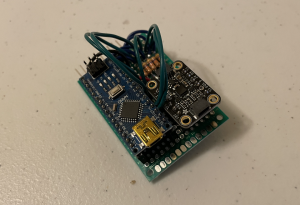This week I focused on building the glove prototype since all of our parts and sensors came in. I had started at the end of last week and wanted to finish by the end of the weekend but unfortunately it took longer than expected.

I soldered the connections on a protoboard. I made sure to place all the components so that the Arduino USB port would connect the USB cord parallel with the arm. And I also soldered 90 degree male pinouts so that the flex sensors can be removed from the Arduino. And The Arduino and IMU breakout are sitting on some female pinouts so they can be easily removed later as well.
My sewing skills are not very good. It was difficult to sew the flex sensors onto the glove in the perfect position so that they remained aligned along the finger when the fingers bent. Some of the stitches will probably have to be redone in the future.
I also wrote the Arduino sketch to read and output all the values from the sensors at the same time.
Since we built a working prototype on protoboard, we’re not sure if we even need to order a PCB. However, we could make the hardware a lot smaller if we do design one.

